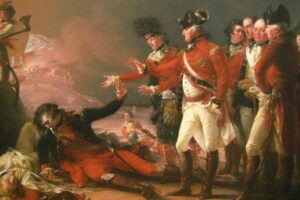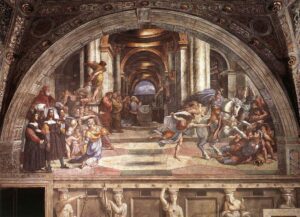Grand Manner art is a style that’s all about elevating subjects to heroic levels.
It’s a tradition that transforms the ordinary into the sublime, making it a fascinating subject for any art enthusiast.
We’ll jump into the origins of Grand Manner, exploring how it’s shaped the portrayal of figures and landscapes in Western art.
Stay with us as we uncover the grandeur and the techniques that define this impressive artistic approach.
Origins Of Grand Manner
Grand Manner’s roots trace back to the idealized aesthetics of classical art forms.
Think of the ancient statues with their composed postures and the epics that narrate tales of valor – these were the blueprints for a style that would dominate Western art in later centuries.
Renaissance artists, deeply inspired by classical antiquity, paved the way with their devotion to harmony, proportion, and the idealized human figure.
By the 18th century, these classical principles had deeply infiltrated the arts, giving birth to what we now call Grand Manner.
Artists like Joshua Reynolds and Thomas Gainsborough took these concepts to new heights.
Reynolds, in particular, championed this style through his role as the first president of the Royal Academy of Arts in London, advocating for a type of painting that transcended the mere replication of nature.

Key characteristics of Grand Manner include:
- Elevated and idealized portrayal of subjects,
- Grandiose scale and composition,
- Use of historical, mythical, or allegorical themes.
These elements work in concert to invoke a sense of awe and reverence, epitomized by works like The Death of General Wolfe and The Blue Boy.
The emphasis is on crafting a noble depiction that far exceeds the ordinariness of everyday life.
In film, we strive for a similar impact, where cinematography, set design, and narrative work together to present a reality that’s grander and more stylized than our own.
Grand Manner’s emphasis on heroic representation also influenced portraiture.
Elite individuals no longer desired simple likenesses but sought to be immortalized in a manner that suggested their own nobleness and virtue.
This aspiration for greatness mirrored in art continues to be a compelling factor in both traditional canvas and modern digital mediums.
Transforming The Ordinary Into The Sublime
In Grand Manner art, the transformation of everyday subjects into illustrious figures is a testament to the power of the artist’s creativity and technique.
This stylistic approach elevates the status of the ordinary, imbuing it with a sense of gravity and significance that transcends its original context.
By adopting grandiose scales and idealized forms, artists blur the lines between reality and the lofty ideals of heroism and virtue.
Paintings such as The Death of General Wolfe by Benjamin West exemplify this, converting a contemporary event into a timeless epic tableau.
The piece doesn’t merely document; it exalts.
Consider these key elements in transforming the ordinary:
- Selection of a significant moment or figure,
- Idealization of the subject to emphasize its intrinsic worth,
- Use of classical references to connect to a broader historical and cultural narrative.
In the realm of filmmaking, this principle is reflected when directors and cinematographers craft scenes that resonate with viewers on a deeper level.
Through the careful use of lighting, composition, and narrative, films like The Godfather or Schindler’s List deliver powerful interpretations of their subjects, leaving audiences with profound messages that linger.
Likewise, our understanding of Grand Manner art should not be confined to its historical roots.
Its influence extends into the contemporary, where creators in all mediums strive to capture that same grandeur.

Whether it’s through the lens of a camera or the brush on a canvas, the ambition remains – to elevate and to inspire.
Portrayal Of Figures In Grand Manner
When delving into the Grand Manner art, we find the portrayal of figures to be nothing short of striking.
Artists adept in this style often depicted their subjects with an air of nobility and virtue that transcended mere likeness.
Grandeur and Poise were conveyed through the precise positioning of figures within a composition.
The artists ensured that every gesture, expression, and attribute contributed to an overarching sense of dignity and importance.
Paintings like The Blue Boy by Thomas Gainsborough exemplify this through the relaxed yet authoritative posture of its young subject.
In filmmaking, we interpret Grand Manner through cinematic techniques that elevate character representation –
- Specific lighting to accentuate noble features,
- Composition of scenes that reflect classical balance and harmony,
- Costuming and set designs that emulate grandiose eras.
Gone with the Wind and The Grand Budapest Hotel are cinematic masterpieces displaying characters with an extraordinary sense of presence, much in the vein of Grand Manner portraiture.
Through such meticulous crafting of characters and scenes, artists and filmmakers alike imbue their subjects with a timeless quality.
They not only capture physical likenesses but also enshrine the ideals and values that define true magnificence.
Portrayal Of Landscapes In Grand Manner
Transforming vistas into visual poetry, Grand Manner landscapes often convey far more than mere natural beauty.
These grand scenes serve not just as backdrops but as pivotal players within the art form.
When we explore the depiction of landscapes in Grand Manner painting, certain characteristics become evident.
Scale and drama play crucial roles, often rendering scenes with a sublime or heroic quality.
This distinction elevates the landscape from a passive setting to an active element with emotive power.
The ethereal depiction of nature in View of the Stour near Dedham underscores this approach, with landscapes illustrated as idealized versions of reality.
Key elements include:
- Harmonious composition,
- Idealized lighting,
- Emotive atmosphere.
Filmmakers assimilating Grand Manner ideals into cinematic landscapes also prioritize these elements.
The scenic grandeur in films creates an immersive experience that echoes the majestic aura of Grand Manner landscapes.
In creating sweeping movie landscapes, directors and cinematographers manipulate lighting, color, and scope to establish an emotionally resonant setting.
A significant achievement in this context is the landscape’s ability to transcend its status as mere scenery to become a character of its own, mirroring the techniques used in historical Grand Manner paintings.
By merging these classical art techniques with modern technology, Grand Manner’s influence has seamlessly transitioned into the realm of filmmaking.
Not only does this celebrate the rich heritage of the style, but it bridges the gap between traditional canvas and contemporary screen.
Techniques In Grand Manner
Within the pantheon of art history, Grand Manner encompasses an array of techniques that elevate the ordinary to extraordinary.
These techniques are not mere strokes of the brush but deliberate strokes of genius.
At the forefront is the manipulation of scale – artists infuse vast canvases with subjects that command attention while still harmonizing with their surroundings.
Paintings like The Oath of the Horatii capture the viewer’s gaze with their larger-than-life figures, dramatically underscored by an expansive backdrop.
Central to Grand Manner is the impeccable composition.
This involves:
- Strategic placement of elements to guide the eye – Balance between different aspects of the scene – Use of diagonals and pyramidal structures for dynamism.
Lighting, too, is key – it’s not just illumination but a storytelling tool.
The chiaroscuro effect, exemplified in works like The Death of General Wolfe, uses stark contrasts to model subjects, infuse depth, and invoke mood.
Color in Grand Manner does more than decorate – it evokes.
Through the use of idealized color palettes, artists provide emotional resonance that transcends the literal hues found in nature.
Whether it’s the pastoral calmness in The Arcadian Shepherds or the tumultuous vibrancy of The Raft of the Medusa, color propels the narrative forward.
Another critical technique involves the deliberate arrangement of figures.
Poses are not random but carefully orchestrated to enhance the emotional undercurrent.
Subtle gestures, directed gazes, and interactive groupings create a visual dialogue that’s as potent as any written narrative.
Our engagement with Grand Manner isn’t simply a matter of visual pleasure but an immersive experience.

As filmmakers, we recognize these techniques as timeless, bridging centuries of artistic Try to resonate with audiences across various mediums.
What Is Grand Manner In Art – Wrap Up
We’ve explored the transformative power of Grand Manner art and its enduring influence across creative disciplines.
These techniques aren’t just about aesthetics; they’re about crafting narratives that captivate and transport us.
As we’ve seen, the principles behind Grand Manner continue to inspire modern storytelling, proving that great art resonates beyond its era.
Let’s keep appreciating the depth and drama these methods bring to our visual experiences, whether in galleries or on the silver screen.
Frequently Asked Questions
What Is Grand Manner Art?
Grand Manner art refers to a style of painting that aims to elevate ordinary subjects to a level of nobility and greatness through specific artistic techniques.
Which Techniques Are Used In Grand Manner Art?
Techniques used in Grand Manner art include manipulating scale, strategic composition, the use of lighting as a storytelling tool, adopting idealized color palettes, and the deliberate arrangement of figures.
How Does Grand Manner Art Affect The Viewer’s Experience?
Grand Manner art creates an immersive experience for the viewer by transforming ordinary landscapes into extraordinary scenes that evoke a sense of grandeur and drama.
Do Filmmakers Employ Grand Manner Art Techniques?
Yes, filmmakers utilize Grand Manner art techniques to craft visually compelling stories that resonate with audiences, due to the timeless nature of these techniques.
Why Are The Color Palettes In Grand Manner Art Described As ‘idealized’?
The color palettes in Grand Manner art are considered ‘idealized’ because they are carefully chosen to enhance the emotional and aesthetic appeal of the scene, rather than strictly adhering to naturalism.


